 W
WAn intermodal container, often called a shipping container, is a large standardized shipping container, designed and built for intermodal freight transport, meaning these containers can be used across different modes of transport – from ship to rail to truck – without unloading and reloading their cargo. Intermodal containers are primarily used to store and transport materials and products efficiently and securely in the global containerized intermodal freight transport system, but smaller numbers are in regional use as well. These containers are known under a number of names, such as simply container, cargo or freight container, ISO container, shipping, sea or ocean container, sea van or (Conex) box, container van, sea can or c can.
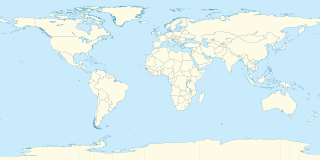 W
WThe Box or BBC Box was a single ISO intermodal container that was tracked by BBC News between September 2008 and April 2009, as part of a project to study international trade and globalisation. The Box was fitted with tracking equipment and painted in a special one-off livery.
 W
WThis article lists the world's busiest container ports by total number of twenty-foot equivalent units (TEUs) transported through the port. The table lists volume in thousands of TEU per year.
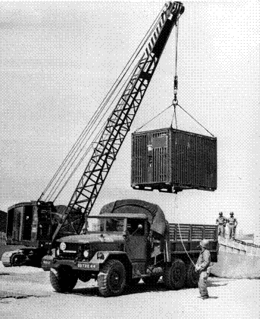 W
WThe CONEX box was developed during the Korean War and was used to transport and store supplies during the Korean and Vietnam war. It was reinvented by Malcom McLean to form the standard Intermodal shipping container that is used widely by container shipping companies today.
 W
WA container crane is a type of large dockside gantry crane found at container terminals for loading and unloading intermodal containers from container ships.
 W
WThe Container Security Initiative (CSI) was launched in 2002 by the U.S. Bureau of Customs and Border Protection (CBP), an agency of the Department of Homeland Security. Its purpose was to increase security for container cargo shipped to the United States. As the CBP puts it, the intent is to "extend [the] zone of security outward so that American borders are the last line of defense, not the first."
 W
WContainer ships are cargo ships that carry all of their load in truck-size intermodal containers, in a technique called containerization. They are a common means of commercial intermodal freight transport and now carry most seagoing non-bulk cargo.
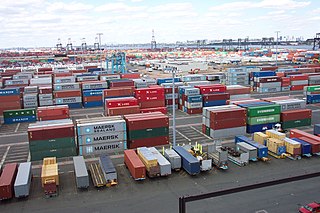 W
WContainerization is a system of intermodal freight transport using intermodal containers. The containers have standardized dimensions. They can be loaded and unloaded, stacked, transported efficiently over long distances, and transferred from one mode of transport to another—container ships, rail transport flatcars, and semi-trailer trucks—without being opened. The handling system is completely mechanized so that all handling is done with cranes and special forklift trucks. All containers are numbered and tracked using computerized systems.
 W
WContainerized Housing Unit, usually abbreviated as CHU is the name given to an ISO shipping container pre-fabricated into a living quarters. Such containers can be transported by container ships, railroad cars, planes, and trucks that are capable of transporting intermodal freight transport cargo.
 W
WDouble-stack rail transport is a form of intermodal freight transport in which railroad cars carry two layers of intermodal containers. Invented in the United States in 1984 it is now being used for nearly seventy percent of United States intermodal shipments. Using double stack technology, a freight train of a given length can carry roughly twice as many containers, sharply reducing transport costs per container. On United States railroads special well cars are used for double-stack shipment to reduce the needed vertical clearance and to lower the center of gravity of a loaded car. In addition, the well car design reduces damage in transit and provides greater cargo security by cradling the lower containers so their doors cannot be opened. A succession of larger container sizes have been introduced to further increase shipping productivity in the United States.
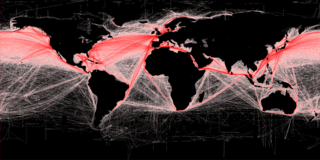 W
WFreight transport is the physical process of transporting commodities and merchandise goods and cargo. The term shipping originally referred to transport by sea but in American English, it has been extended to refer to transport by land or air as well. "Logistics", a term borrowed from the military environment, is also used in the same sense.
 W
WThe HP Performance Optimized Datacenter (POD) is a range of three modular data centers manufactured by HP.
 W
WISO 6346 is an international standard covering the coding, identification and marking of intermodal (shipping) containers used within containerized intermodal freight transport. The standard establishes a visual identification system for every container that includes a unique serial number, the owner, a country code, a size, type and equipment category as well as any operational marks. The standard is managed by the International Container Bureau (BIC).
 W
WThe Portable Modular Data Center (PMDC) is a portable data center solution built into a standard 20, 40, or 53-foot intermodal container manufactured and marketed by IBM. IBM states that a PMDC cost 30% less to design and build than a traditional data center with cooling equipment.
 W
WA reach stacker is a vehicle used for handling intermodal cargo containers in small terminals or medium-sized ports. Reach stackers are able to transport a container short distances very quickly and pile them in various rows depending on its access.
 W
WA refrigerated container or reefer is an intermodal container used in intermodal freight transport that is refrigerated for the transportation of temperature-sensitive cargo.
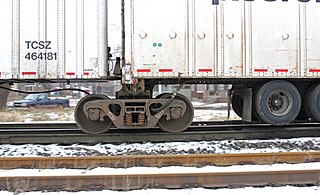 W
WIn railroad terminology, a Roadrailer or RoadRailer is a highway trailer or semi-trailer that is specially equipped for use in railroad intermodal service.
 W
WA roller container is a container type that can be carried by trucks to be pushed to ground level by help of a hook and level arm with the container possibly sliding on steel roller wheels.
 W
WA rubber tyred gantry crane is a mobile gantry crane used in intermodal operations to ground or stack containers. Inbound containers are stored for future pickup by drayage trucks, and outbound are stored for future loading onto vessels. RTGs typically straddle multiple lanes, with one lane reserved for container transfers. Advantages:its mobility gives a rubber tyred gantry crane wide appliance
 W
WA sidelifter is a specialised vehicle or semi-trailer used to hoist and transport ISO standard intermodal containers over longer distances.
 W
WStowage plan for container ships or bay plan is the plan and method by which different types of container vessels are loaded with containers of specific standard sizes. The plans are used to maximize the economy of shipping and safety on board.
 W
WA straddle carrier or straddle truck is a freight-carrying vehicle that carries its load underneath by "straddling" it, rather than carrying it on top like a conventional truck. The advantage of the straddle carrier is its ability to load and unload without the assistance of cranes or forklifts. The lifting apparatus under the carrier is operated by the driver without any outside assistance and without leaving the driver's seat.
 W
WSun Modular Datacenter is a portable data center built into a standard 20-foot intermodal container manufactured and marketed by Sun Microsystems. An external chiller and power were required for the operation of a Sun MD. A data center of up to 280 servers could be rapidly deployed by shipping the container in a regular way to locations that might not be suitable for a building or another structure, and connecting it to the required infrastructure. Sun stated that the system could be made operational for 1% of the cost of building a traditional data center.
 W
WA tank container or tanktainer is an intermodal container for the transport of liquids, gases and powders as bulk cargo.
 W
WThe twenty-foot equivalent unit is an inexact unit of cargo capacity often used to describe the capacity of container ships and container terminals. It is based on the volume of a 20-foot-long (6.1 m) intermodal container, a standard-sized metal box which can be easily transferred between different modes of transportation, such as ships, trains and trucks.
 W
WA twistlock and corner casting together form a standardized rotating connector for securing shipping containers. The primary uses are for locking a container into place on a container ship, semi-trailer truck or railway container train, and for lifting of the containers by container cranes and sidelifters.
 W
WThe United States has more than 20 container ports around its coastline.
 W
WA well car, also known as a double-stack car or stack car, is a type of railroad car specially designed to carry intermodal containers used in intermodal freight transport. The "well" is a depressed section which sits close to the rails between the wheel trucks of the car, allowing a container to be carried lower than on a traditional flatcar. This makes it possible to carry a stack of two containers per unit on railway lines wherever the structure gauge assures sufficient clearance. The top container is secured to the bottom container either by a bulkhead built into the car, or through the use of inter-box connectors (IBC). Four IBCs are needed per wellcar. In the process of an inbound train becoming an outbound train, there are four processes: unlock to unload the top container of inbound train, remove then unload bottom container, insert after loading bottom container of outbound train, lock after top container loaded.